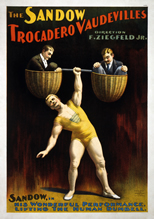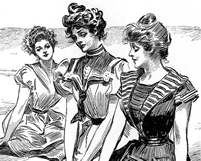Edison Shorts
So, what were people seeing in these kinetoscope parlors?
Well, we can only partially answer the question. The vast majority of films that were shown on these machines (as well as the vast majority of early motion pictures in general) are lost. The film itself could be melted down and recycled, and it often was.
The Edison shorts shown in this class include the following:
 The Kiss: one of the first films ever shown commercially, it reenacts the final scene of the popular New York stage musical The Widow Jones staring May Irwin (1862-1938) and John Rice (1857-1915). Edison promoted the film heavily. The promotional material for the film says: "They get ready to kiss, begin to kiss, and kiss and kiss and kiss in a way that brings down the house every time." This was considered scandalous in 1896 when the film was released. The film was exactly 50 feet long and sold for $7.50 (about $200 in 2015 money). YouTube:https://youtu.be/Q690-IexNB4
The Kiss: one of the first films ever shown commercially, it reenacts the final scene of the popular New York stage musical The Widow Jones staring May Irwin (1862-1938) and John Rice (1857-1915). Edison promoted the film heavily. The promotional material for the film says: "They get ready to kiss, begin to kiss, and kiss and kiss and kiss in a way that brings down the house every time." This was considered scandalous in 1896 when the film was released. The film was exactly 50 feet long and sold for $7.50 (about $200 in 2015 money). YouTube:https://youtu.be/Q690-IexNB4
 Sandow Strong Man was filmed in 1894 and featured Eugen Sandow, today considered "the father of modern bodybuilding." Sandow performed for theatrical impresario Florenz Ziegfeld. Ziegfeld found that audiences were more interested in Sandow's muscles than in actual feats of strength. Sandow was a favorite and several different Sandow movies were made. At the time Sandow was billed as "The Modern Hercules." YouTube: https://youtu.be/bZYu3qsxkOo
Sandow Strong Man was filmed in 1894 and featured Eugen Sandow, today considered "the father of modern bodybuilding." Sandow performed for theatrical impresario Florenz Ziegfeld. Ziegfeld found that audiences were more interested in Sandow's muscles than in actual feats of strength. Sandow was a favorite and several different Sandow movies were made. At the time Sandow was billed as "The Modern Hercules." YouTube: https://youtu.be/bZYu3qsxkOo
Florenz Ziegfeld (1867-1932) is most often associated with the Ziegfeld Follies. Inspired by the Folies Bergere in Paris, the Ziegfeld folliles were a series of Broadway review programs (kind of like upscale vaudeville) staged between 1907 and the mid 1930s. There have been numerous films about them. Many, many Hollywood stars appeared in the Follies.
 Serpentine Dance was made in 1895. It featured Annabelle Moore, also known as "Peerless Annabelle." Several different versions of this film were made and it was one of the earliest colored films. Moore was only about 16 when this film was made. However she went on to do other dance films including Butterfly Dance and Sun Dance. She also went to work for Florenz Ziegfeld and appeared in Ziegfeld Follies until 1912. She was also the original "Gibson Girl." Gibson girls actually drawings by Charles Dana Gibson, but they were held to epitomize an early 20th century idea of female beauty (image left).
Serpentine Dance was made in 1895. It featured Annabelle Moore, also known as "Peerless Annabelle." Several different versions of this film were made and it was one of the earliest colored films. Moore was only about 16 when this film was made. However she went on to do other dance films including Butterfly Dance and Sun Dance. She also went to work for Florenz Ziegfeld and appeared in Ziegfeld Follies until 1912. She was also the original "Gibson Girl." Gibson girls actually drawings by Charles Dana Gibson, but they were held to epitomize an early 20th century idea of female beauty (image left).
YouTube: https://youtu.be/sNXNfcEo5dQ
Glenroy Brothers Comic Boxing No. 2. 1894. Part of a vaudeville act called "The Comic View of Boxing: The Tramp and the Athlete." At least 2 Glenroy Brothers films were made. YouTube: https://youtu.be/Zzz4Y43P0so
Seminary Girls. According to the Edison catalog: "A number of young ladies, in their night robes, are having a frolic and are interrupted by a teacher. One girl makes herself very conspicuous by crawling under a bed. 50 feet, $7.50. YouTube: https://youtu.be/k0Hs_7cnxsM
All of these films were very simple, very short, single shot films. All were filmed in Edison's Black Maria. The process was simple: the lighting was set, the actors performed in the main room of the studio. The camera was turned on, the camera was turned off.
As I've said many times, we truly cannot see these films the way that their early audiences did. Those audiences saw moving pictures as truly something new, something that, for all practical purposes, no one had experienced before. Adults could be endlessly fascinated by simply watching motion on film...for a while anyway. However, in addition to the fascination with motion, we also can't really see these films through the cultural and moral lenses of the time. This was scandalous stuff! When Edison showed The Kiss, public kissing was still illegal in many places! All of these films demonstrate a fascination with and an intimacy with the body (yes, particularly women's bodies but don't forget Sandow and the Glenroys) that hovered right on the edge of both legality and respectability.
That kinetoscope parlors hovered on the edge of respectability was important. This was NOT family entertainment. The clients of early kinoscope parlors were overwhelmingly young working class men. These were not places where women, children, or anyone who had a pretense to social standing would want to be seen. In the context of the era, movies were considered just narrowly above pornography. This implied that movies had a problem: if they were going to be successful in the long run, they had to get a lot better and movie makers needed to convince audiences that movies were appropriate entertainment for everyone. In 1896, H. S. Stone, the editor of The Chap Book (a literary review journal) wrote that The Kiss was "absolutely disgusting" and "comes very near being indecent in its emphasized vulgarity." Stone declared "Such things call for police interference." Movie makers have continued to battle charges of immorality and calls for official censorship
[For history and trivia buffs: Stone sounds like an angry old man but he was in his 20s when he wrote those words. Stone had ticket number 46069 on the Lusitania and went down with the ship in 1915 (the Lusitania was a passenger ship that was sunk by a German U boat. It was one of reasons for (or the excuses for) the US entry into WWI).]